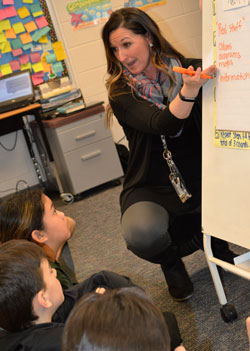When Ian Schoonveld was passed the furry red beanbag lobster that signified it was his turn to talk, the Ada Elementary fourth-grader had an honest question for his classmates.
“I think we already read enough,” Ian said earnestly. “I mean, I just don’t get why.”

It wasn’t that Ian doesn’t like to read. Just minutes later, he would make a beeline for a picture book about velociraptors, about which he admitted he is very curious.
And those in the talking circle in teacher Stacy Redmond’s class had plenty of reasons why reading makes all kinds of sense right through school and beyond.
“OK, let’s say you had a really weird zoo test, like, on manatees. You would have to read nonfiction books to get some facts,” offered Kristin Hotaling.
“I learned from a nonfiction book that Hershey created the first (American-made) mass-produced chocolate bar,” said Julian Fernandez. “When you read something like that, even more information comes into your brain.”
Added Julia Merhi: “Sometimes you just want to learn about something you never thought of before.”
And finally, from Redmond: “Let’s take math. Math is nonfiction. We know math doesn’t go away. It helps you all through your life: in high school, in your job, to balance your checkbook. You never stop doing math.”

Can You Explain?
More and more school districts are using restorative practices as a proactive way to handle behavioral issues. At Ada Elementary, teachers have started to use them — and a practice called “accountable talk” (see below) — when teaching content.
This is typically done with students sitting in a circle to discuss a topic. A “talking piece” is passed so only the student who holds it has permission to speak. Accountable talking prompts such as “Tell me more about” and “I respectfully disagree because” help students focus on what they want to share and develop conversational skills.
There also is the circle-within-a-circle format, or fishbowl, arranged so students on the perimeter can observe and make notes on those in the inner circle as they have a discussion or work to solve a problem.
“It’s been, I would say, a game-changer,” Principal Kim VanAntwerp said. “It’s been amazing. When they go back to work independently, they’ve thought it through so much better.”
Redmond said there’s “been more engagement for sure, even for the most quiet, reserved kids. When you circle them up, it’s community building, teaching them how to communicate with one another and to be good citizens. I saw a difference on day one.”
As a 19-year teaching veteran, Redmond said she has had many professional development opportunities. “Restorative practices training has been, by far, the most influential,” she said. “It changed the way I teach and changed the way my students communicate with each other.”

Learning from Each Other
During a recent math lesson, teacher Bridget Bennett was visibly giddy as she sat on the outer circle of a fishbowl, while four of her students in the inner circle worked to figure out how to fit a million dollars in $1 bills into a box.
“Holy Moly, there was a lot of learning going on in there!” she remarked to the class.
Later, Bennett would marvel at how restorative circles have transformed her classroom, both physically and “especially with the relationships between all of my students.”
“Students are more understanding of one another and have learned how to better communicate their thoughts and feelings,” she said. “Circles are also a great way to check in on content that we are learning about. When all students have a voice, specifically about the content, they are able to learn from one another, ask questions, and even push their thinking beyond what I am teaching.”
Students agree.
“They really give us a feel for collaborating with each other,” said Gibby Wierenga.
Added Josie Nugent: “Circles allow us to talk about something and not be embarrassed.”
CONNECT













